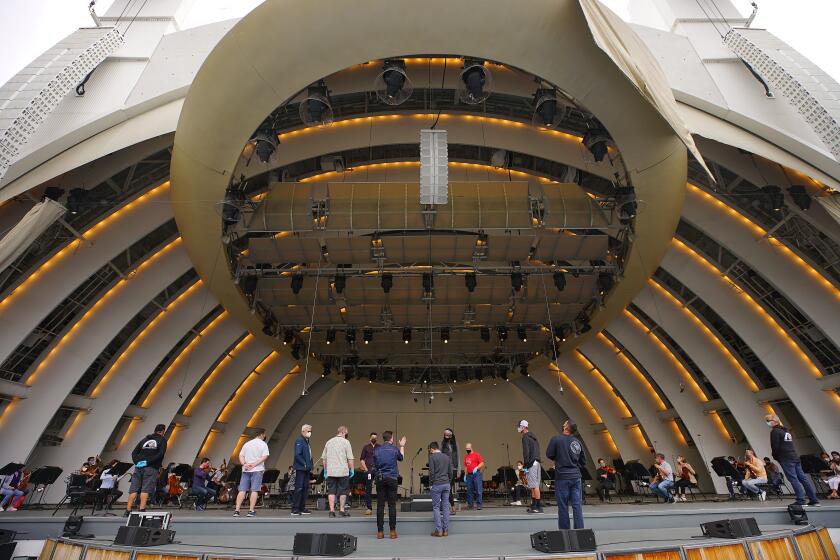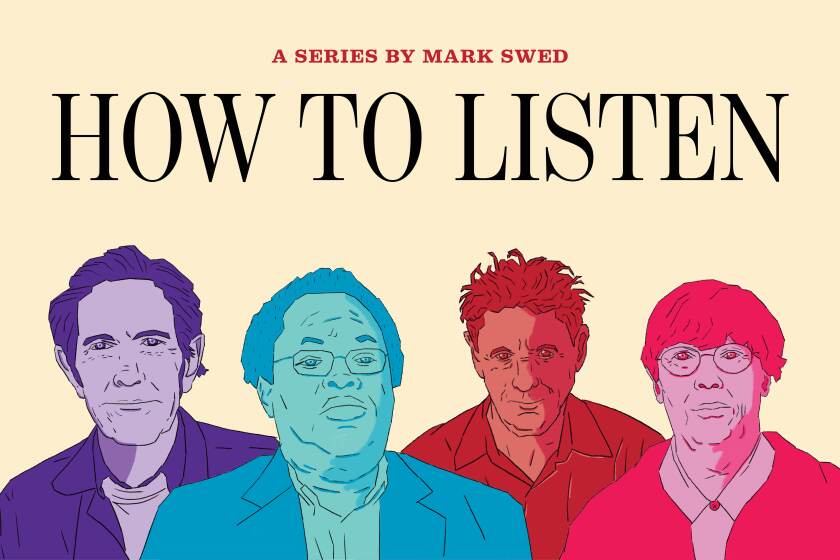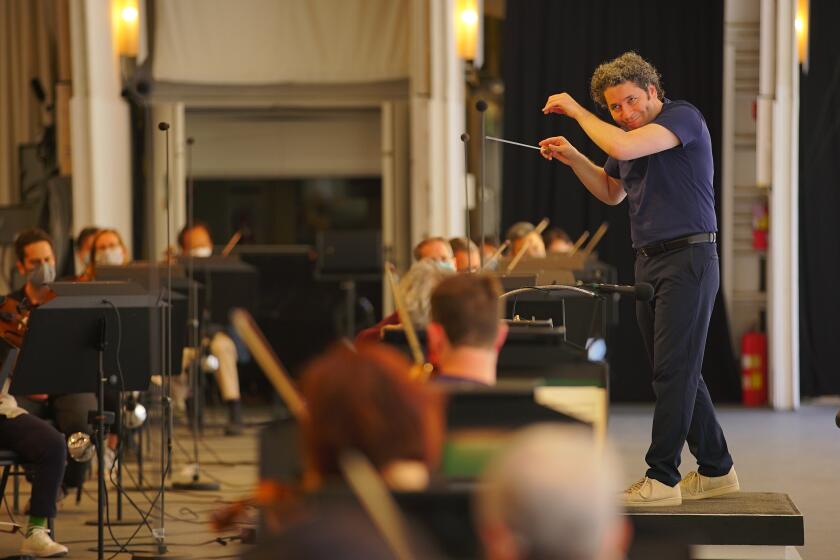Review: ‘Like a resurrection,’ Gustavo Dudamel brings the Hollywood Bowl back to life
- Share via
Unpracticed in saying goodbye, the Los Angeles Philharmonic went silent uneasily 14 months ago. The COVID-19 pandemic hit a uniquely imaginative, welcoming and wealthy orchestra especially hard. Cancellations initially thought to be brief became unthinkably lengthy. Coming back with customary innovation added to the challenge.
But after a season of short, experimental streamed concerts by Gustavo Dudamel and a masked and distanced orchestra in an otherwise empty Hollywood Bowl — awkward in the first round, engaging in the second — the L.A. Phil finally employed its traditional skill set Saturday night, saying hello in a special concert for the pandemic’s first responders.
“Welcome back” resonated throughout the Bowl, from parking attendants to ticket takers, food servers to ushers. Those were also Dudamel’s first words when he took the stage. “For us, it’s like a resurrection,” he told his audience. Thanking health workers again and again, he added, “Health is everything.”
Did it feel good to be back in the Bowl? Of course, what with live musicians, a live audience and all that. It felt fabulous to be in the company of some 4,000 first responders and guests. Resurrection is not too strong a word.
Timeline of a comeback: historic cancellation of an entire season, painful layoffs, transformation into a recording studio, a whirlwind race to reopen.
But, as I’m sure every one of the healthcare workers could have told us, first comes recovery, one step at a time. Saturday was a first step.
It was the Bowl, but not yet the full Bowl. It was the L.A. Phil, not yet the full L.A. Phil. Los Angeles County is not rushing to loosen mask and distancing restrictions before we’re ready. Unlike some orchestral concerts elsewhere, players continue to maintain distance. For obvious reasons, winds and brass are kept farther away. Those who can be masked are.
The Bowl itself looked like a piece of Swiss cheese, full of empty spaces in the audience. We were mostly seated farther than 6 feet apart. The evening did not begin with the customary national anthem. We’re not there yet when it comes to crowd singing.
Nor is the orchestra yet ready to don summer white jackets; the players instead stuck to their more formal concert hall black dress, adding to a more sober atmosphere than normal at the Bowl. But a delightful surprise appearance by Billie Eilish, welcoming the audience, did liven up the mood.
The program was laced with meaning. Jessie Montgomery’s 2012 “Starburst” served as a new “Star-Spangled Banner.” A lively, lyrical, three-minute soundscape of stars marvelously making a galaxy stood in nicely for our own communal hopes. Montgomery, moreover, was one of the featured composers in the L.A. Phil’s Power to the People! festival, which was interrupted by the COVID-19 shutdown last year.
Dudamel used Samuel Barber’s Adagio for Strings as a tribute, he said, to “all the beautiful souls” lost in the pandemic. As he was about to begin, a helicopter slowly crossed the Bowl. Dudamel stood motionless at the podium, waiting for it to exit, as though it were ferrying those souls to other worlds. The sight of empty seats and empty spaces onstage became wrenching, all the more so as I took in the scene through mask-induced fogged glasses on a cold night. Dudamel conducted without a baton, with his hands spread widely open, holding on as long as possible to a bodily vibrating string sound.
No, this was not a normal Bowl concert. It should be no surprise that the main work, Beethoven’s Symphony No. 3, was a normal “Eroica,” its purpose here to signify, Dudamel announced, “the heroism of all of you.”
Coronavirus may have silenced our symphony halls, taking away the essential communal experience of the concert as we know it, but The Times invites you to join us on a different kind of shared journey: a new series on listening.
Nine years ago, Dudamel recorded the work with his oversize Simón Bolívar Symphony Orchestra. It’s probably the most robust “Eroica” on record, arresting in its magnificence, startling in the massive unity of so many players, cinematic in its depiction of the heroic by a then-31-year-old conductor leading his army of young musicians overcoming all obstacles.
Saturday’s “Eroica” couldn’t have been more different. The reduced L.A. Phil was maybe a quarter the size of those Bolívars. Orchestra players seated apart have said that their concentration can become newly focused, so hard must they listen. But the reality is that lockstep coordination is inevitably compromised. The other reality is that the overall sound of the symphony will be thinner. No matter how often chamber orchestras program it and illuminate its revolutionary details, “Eroica” wants a big sound.
The Bowl’s admirable amplification helped to create a unified soundstage, but the larger sensation was more of striving than achievement. The second movement, one of the most monumental funeral marches in all music, had a full degree of emotion, but it was muted emotion, reminding us of the hundreds of thousands mourned this last year without proper funerals.
The Scherzo was like a reset. Nothing could be harder than trying to maintain its rhythmic intricacies at the exciting tempos Dudamel excels at. We could watch him on the video screen carefully beating out the measures, slower than he would surely have otherwise. The L.A. Phil pulled it off, but not effortlessly, as it always has.
The outer movements are a psychologically complex picture of heroism. Entranced by the French Revolution, Beethoven had thought of moving from Vienna to Paris around the time of the “Eroica” premiere in 1804. Though initially inspired by Napoleon, a disillusioned Beethoven famously scratched out his dedication of the “Eroica” to the emperor.
But this “Eroica” — in its shockingly-for-the-time dramatic first movement and lively set of variations growing in triumph at the end — had a sense of striving that became ineffably stirring. Read into it what you will, but perhaps this also signifies Dudamel’s own nuanced attitude toward his upcoming musical move to Paris, where he will soon share an operatic music directorship with his symphonic one in L.A.
However stirring, this was an unsettling “Eroica” of unfinished business that Dudamel clearly did not want to be a celebratory evening’s final word. His encore was an authentically effortless waltz from Leonard Bernstein’s “Divertimento.” Leaving the Bowl was also new. No rushing, just a distanced waltzing.
We kid ourselves if we think we have returned to normalcy. If the L.A. Phil has any power in this crazy world, we could be in two months, when the orchestra opens its summer Bowl season for real. In the meantime, you can hear Saturday’s concert in a repeat broadcast Monday on KUSC-FM (91.5). Keep a hanky handy.
A landmark in hibernation, a surprise from the governor, tears and hugs: Behind the scenes of the whirlwind push to bring music back to the Bowl.
More to Read
The biggest entertainment stories
Get our big stories about Hollywood, film, television, music, arts, culture and more right in your inbox as soon as they publish.
You may occasionally receive promotional content from the Los Angeles Times.














